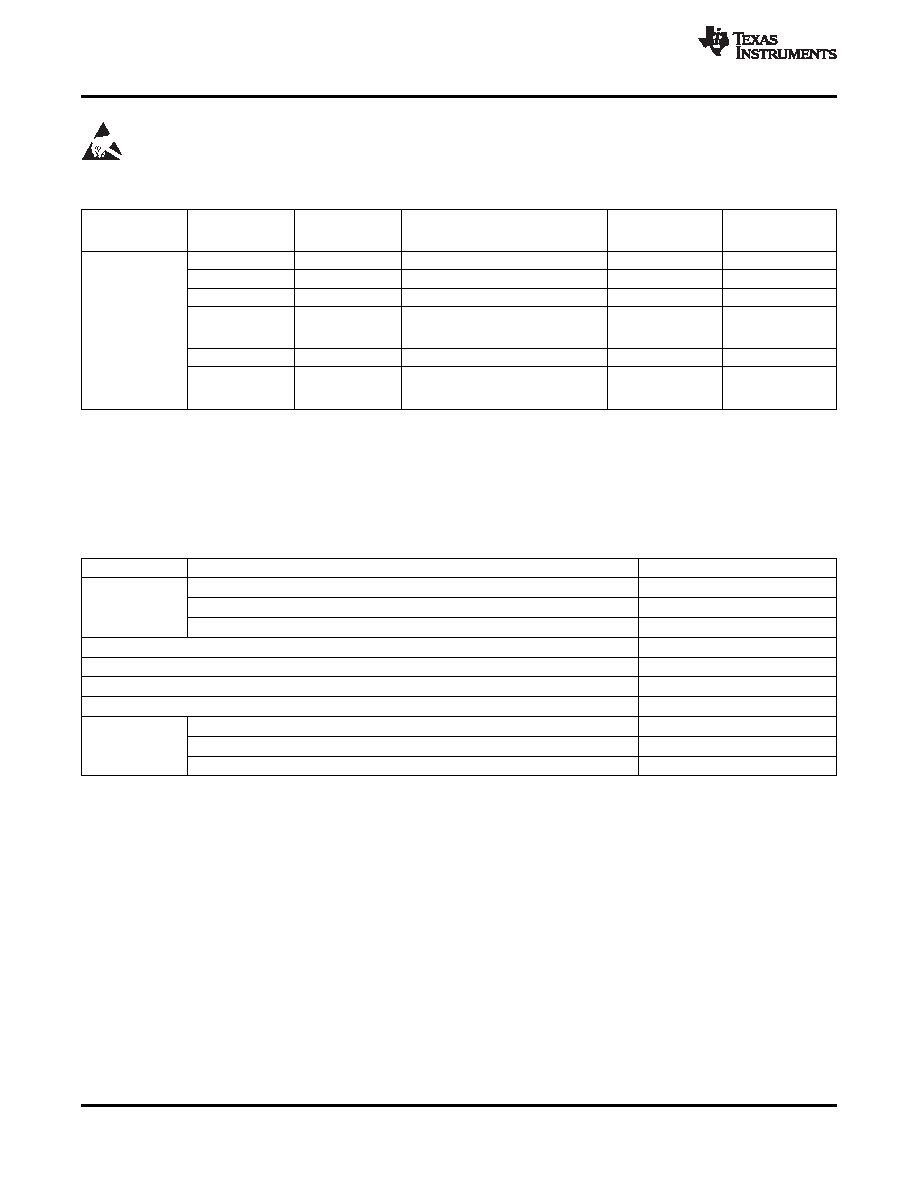- 您現在的位置:買賣IC網 > PDF目錄98285 > TPS62679ZYFMR (TEXAS INSTRUMENTS INC) 1.15 A SWITCHING REGULATOR, 6000 kHz SWITCHING FREQ-MAX, PBGA6 PDF資料下載
參數資料
| 型號: | TPS62679ZYFMR |
| 廠商: | TEXAS INSTRUMENTS INC |
| 元件分類: | 穩壓器 |
| 英文描述: | 1.15 A SWITCHING REGULATOR, 6000 kHz SWITCHING FREQ-MAX, PBGA6 |
| 封裝: | 0.40 MM HEIGHT, GREEN, DSBGA-6 |
| 文件頁數: | 12/34頁 |
| 文件大小: | 1129K |
| 代理商: | TPS62679ZYFMR |
第1頁第2頁第3頁第4頁第5頁第6頁第7頁第8頁第9頁第10頁第11頁當前第12頁第13頁第14頁第15頁第16頁第17頁第18頁第19頁第20頁第21頁第22頁第23頁第24頁第25頁第26頁第27頁第28頁第29頁第30頁第31頁第32頁第33頁第34頁

SLVS952C
– APRIL 2010 – REVISED APRIL 2011
This integrated circuit can be damaged by ESD. Texas Instruments recommends that all integrated circuits be handled with
appropriate precautions. Failure to observe proper handling and installation procedures can cause damage.
ESD damage can range from subtle performance degradation to complete device failure. Precision integrated circuits may be more
susceptible to damage because very small parametric changes could cause the device not to meet its published specifications.
ORDERING INFORMATION(1)
PACKAGE
PART
OUTPUT
DEVICE
TA
ORDERING(3)
MARKING
NUMBER
VOLTAGE(2)
SPECIFIC FEATURE
CHIP CODE
TPS62671
1.8V
PWM Spread Spectrum Modulation
TPS62671YFD
NZ
TPS62672(4)
1.5V
PWM Spread Spectrum Modulation
TPS62672YFD
OA
TPS62673(4)
PWM Spread Spectrum Modulation
TPS62674
1.26V
PWM Operation Only
TPS62674YFD
PN
-40
°C to 85°C
Output Capacitor Discharge
TPS62675
1.2V
PWM Spread Spectrum Modulation
TPS62675YFD
OB
PWM Spread Spectrum Modulation
TPS62679
1.26V
Extended Start-Up Time
TPS62679ZYFM
-
Output Capacitor Discharge
(1)
For the most current package and ordering information, see the Package Option Addendum at the end of this document, or see the TI
website at www.ti.com.
(2)
Internal tap points are available to facilitate output voltages in 25mV increments.
(3)
The YFD package is available in tape and reel. Add a R suffix (e.g. TPS62670YFDR) to order quantities of 3000 parts. Add a T suffix
(e.g. TPS62670YFDT) to order quantities of 250 parts.
(4)
Product preview. Contact TI factory for more information.
ABSOLUTE MAXIMUM RATINGS
over operating free-air temperature range (unless otherwise noted)
(1)
UNIT
Voltage at VIN(2), SW(3)
–0.3 V to 6 V
Input Voltage
Voltage at FB(3)
–0.3 V to 3.6 V
Voltage at EN, MODE (3)
–0.3 V to VI + 0.3 V
Power dissipation
Internally limited
TA
Operating temperature range(4)
–40°C to 85°C
TJ (max)
Maximum operating junction temperature
150
°C
Tstg
Storage temperature range
–65°C to 150°C
Human body model
2 kV
ESD rating (5)
Charge device model
1 kV
Machine model
200 V
(1)
Stresses beyond those listed under absolute maximum ratings may cause permanent damage to the device. These are stress ratings
only and functional operation of the device at these or any other conditions beyond those indicated under recommended operating
conditions is not implied. Exposure to absolute-maximum-rated conditions for extended periods may affect device reliability.
(2)
Operation above 4.8V input voltage for extended periods may affect device reliability.
(3)
All voltage values are with respect to network ground terminal.
(4)
In applications where high power dissipation and/or poor package thermal resistance is present, the maximum ambient temperature may
have to be derated. Maximum ambient temperature (TA(max)) is dependent on the maximum operating junction temperature (TJ(max)), the
maximum power dissipation of the device in the application (PD(max)), and the junction-to-ambient thermal resistance of the part/package
in the application (
θJA), as given by the following equation: TA(max)= TJ(max)–(θJA X PD(max)). To achieve optimum performance, it is
recommended to operate the device with a maximum junction temperature of 105
°C.
(5)
The human body model is a 100-pF capacitor discharged through a 1.5-k
resistor into each pin. The machine model is a 200-pF
capacitor discharged directly into each pin.
2
Copyright
2010–2011, Texas Instruments Incorporated
相關PDF資料 |
PDF描述 |
|---|---|
| TPS62672YFDR | 1.15 A SWITCHING REGULATOR, 6600 kHz SWITCHING FREQ-MAX, PBGA6 |
| TPS62672YFD | 1.15 A SWITCHING REGULATOR, 6600 kHz SWITCHING FREQ-MAX, PBGA6 |
| TPS62676YFDR | SWITCHING REGULATOR, PBGA6 |
| TPS62677YFDR | SWITCHING REGULATOR, PBGA6 |
| TPS62677YFDT | SWITCHING REGULATOR, PBGA6 |
相關代理商/技術參數 |
參數描述 |
|---|---|
| TPS62679ZYFMT | 功能描述:直流/直流開關轉換器 500mA,6MHz Hi-Eff Step-Down Converter RoHS:否 制造商:STMicroelectronics 最大輸入電壓:4.5 V 開關頻率:1.5 MHz 輸出電壓:4.6 V 輸出電流:250 mA 輸出端數量:2 最大工作溫度:+ 85 C 安裝風格:SMD/SMT |
| TPS62684YFFR | 功能描述:Buck Switching Regulator IC Positive Fixed 2.85V 1 Output 1.6A 6-UFBGA, DSBGA 制造商:texas instruments 系列:- 包裝:剪切帶(CT) 零件狀態:有效 功能:降壓 輸出配置:正 拓撲:降壓 輸出類型:固定 輸出數:1 電壓 - 輸入(最小值):3.25V 電壓 - 輸入(最大值):5.5V 電壓 - 輸出(最小值/固定):2.85V 電壓 - 輸出(最大值):- 電流 - 輸出:1.6A 頻率 - 開關:5.5MHz 同步整流器:是 工作溫度:-40°C ~ 85°C(TA) 安裝類型:表面貼裝 封裝/外殼:6-UFBGA,DSBGA 供應商器件封裝:6-DSBGA 標準包裝:1 |
| TPS62690EVM-076 | 功能描述:電源管理IC開發工具 TPS62690 Eval Mod RoHS:否 制造商:Maxim Integrated 產品:Evaluation Kits 類型:Battery Management 工具用于評估:MAX17710GB 輸入電壓: 輸出電壓:1.8 V |
| TPS62690YFFR | 功能描述:直流/直流開關轉換器 500mA,4MHz,2.85Vout Hi-Eff St-Dwn Cnvrtr RoHS:否 制造商:STMicroelectronics 最大輸入電壓:4.5 V 開關頻率:1.5 MHz 輸出電壓:4.6 V 輸出電流:250 mA 輸出端數量:2 最大工作溫度:+ 85 C 安裝風格:SMD/SMT |
| TPS62690YFFT | 功能描述:直流/直流開關轉換器 500mA,4MHz,2.85Vout Hi-Eff St-Dwn Cnvrtr RoHS:否 制造商:STMicroelectronics 最大輸入電壓:4.5 V 開關頻率:1.5 MHz 輸出電壓:4.6 V 輸出電流:250 mA 輸出端數量:2 最大工作溫度:+ 85 C 安裝風格:SMD/SMT |
發布緊急采購,3分鐘左右您將得到回復。